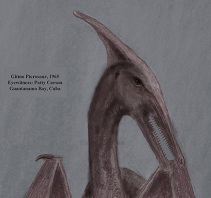I’m a cryptozoologist, specializing in sightings of apparent pterosaurs. How does that relate to the Hydroplate Theory? Walt Brown’s explanations of geology help answer a question that sometimes comes up for me: “How could pterosaurs have survived to the modern day?”
I don’t imply that all species have survived, all kinds of pterosaurs known from fossils. But as far as we can tell from eyewitness descriptions, some pterosaur species that are still living differ only in limited ways from some of those that have left fossil evidence. We know of wonderful features of those flying creatures, from fossils and from sightings of living fliers. Strange as it sounds to Western ears, there is nothing primitive about any pterosaur. We get that idea of primitiveness from generations of deep indoctrination.
We know from countless centuries of breeding animals that size and outward appearance can differ greatly in members of a single species. Even without the major evolutionary changes imagined by Darwin, universally recognized changes (called by some “microevolution”), in size and outward appearance, could add up to a Chihuahua-like animal “evolving” into something like a Great Dane. But why would any animal remain mostly unchanged for millions of years? How unnatural!
My associates and I, who specialize in a narrow niche of cryptozoology, know of eyewitness testimonies that tie one form of modern flying creature to fossils of the Sordes Pilosus, a “basal” or Rhamphorhynchoid pterosaur. How shocking to most biologists! That type of pterosaur was supposed to have mostly become extinct before the shorter-tailed ones dominated the skies. What could be more of a shock than to learn that the more “primitive” pterosaurs are the ones that now dominate eyewitness descriptions of modern flying creatures? So why are some of us not so shocked?
Shrink many millions of years down to only a few thousand years. If the fossils were of creatures living a few thousand years ago, what is so shocking about a few of their species living today? We would then expect modern pterosaurs to be at least somewhat similar to some of those that have left us fossils. That is where hydroplates come in.
The Hydroplate Theory explains many features of our planet, including many facts of geology that have long puzzled scientists who have been indoctrinated into uniformitarianism. It explains processes that caused major changes in a short time, thousands of years ago, including how the bodies of many organisms were fossilized.

Flying creature, not millions of years ago but in 1965 in Cuba
.


